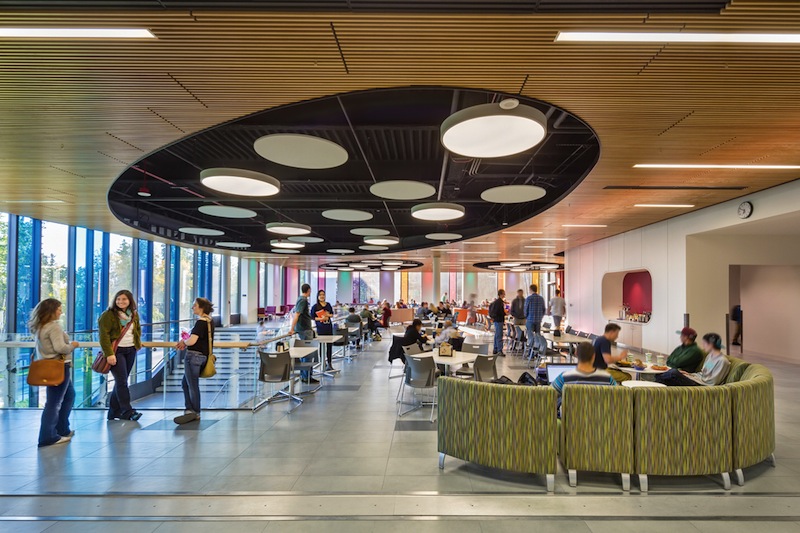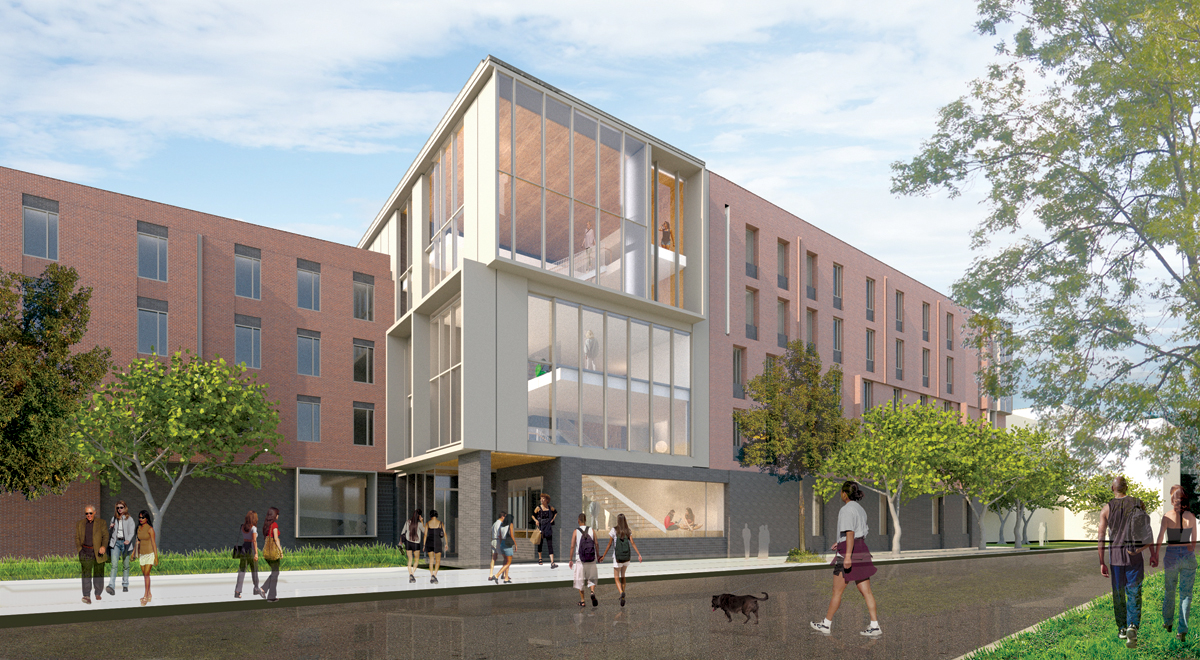With student debt in the U.S. topping $1.2 trillion, and with recent graduates racking up an average $30,000 in loans, it’s no wonder college and university officials are under intense pressure to hold down costs. Campus building projects are hardly exempt from this imperative.
Critics of higher education point to “shiny new facilities” as contributing to ballooning tuition fees and room and board charges. Advocates for new buildings claim they are strategic assets in the battle to recruit and retain top students and faculty.
“Everybody agrees that higher ed is too expensive, but are we going to do without that fitness center and other amenities? No,” says Robert Schulz, AIA, Associate Vice President of Operations and University Architect at San Diego State University.
The tug of war between those seeking to control costs and those demanding ever more attractive campus facilities has put higher education officials in a bind. They continue to greenlight projects to upgrade building stock, but are using a wider breadth of cost-saving strategies to squeeze more value out of every capital dollar.
Here’s a look at how several representative institutions of higher learning are using alternate financing schemes, rigorous programming and design processes, and cost-containment measures to rein in building project expenses.
HOW institutions are using PUBLIC-PRIVATE PARTNERSHIPS to BRIDGe THE FINANCE GAP
Some schools are turning to so-called public-private partnerships to widen their financing capabilities. In a P3 arrangement, the institution contracts with a private developer to design, construct, and manage a new building for an extended period, usually 30 years. University P3 projects must have dedicated revenue streams, so only a few building types qualify: student housing, dining halls, parking facilities, and research centers with rent-paying private-sector tenants.
P3s allow universities to get projects built faster than through traditional design-bid-build, without assuming more debt. The P3 reduces the institution’s exposure to cost overruns, which become the responsibility of the private partner.
Some schools are starting to take the P3 plunge; others are just testing the waters. “This is a major wave of the future,” says John Finke, Senior Managing Director, National Development Council, a P3 owner/developer. Universities are ideal clients for P3 owners due to their stability and willingness to take on long-term leases, he says.
As a nonprofit entity working with nonprofit institutions, NDC uses tax-exempt 501c3 bonds for project funding. P3 specialists are exempt from public procurement rules at public colleges and universities in many states, making it easier to fast-track projects. These advantages mean that a P3 project can usually be built for 15-25% less than conventional design-bid-build projects without reducing quality, says Finke.
 The $104 million, LEED Platinum Conrad Prebys Aztec Student Union at San Diego State University. The four-story, 206,000-sf union has a 300-seat theater, three dining facilities, retail space, a banquet hall, a bowling/games center, a fitness center, a 6,000-sf gym, 13 meeting rooms, and office spaces. The Building Team: CannonDesign (architect), P2S Engineering (MEP/telecom engineer), John A. Martin & Associates (SE), BWE/Burkett & Wong Engineers (CE), Kaplan Gehring McCaroll Architectural Lighting, Carter Romanek Landscape Architects, and Sundt Construction (CM). Photo: © Nick Merrick / Hedrich Blessing
The $104 million, LEED Platinum Conrad Prebys Aztec Student Union at San Diego State University. The four-story, 206,000-sf union has a 300-seat theater, three dining facilities, retail space, a banquet hall, a bowling/games center, a fitness center, a 6,000-sf gym, 13 meeting rooms, and office spaces. The Building Team: CannonDesign (architect), P2S Engineering (MEP/telecom engineer), John A. Martin & Associates (SE), BWE/Burkett & Wong Engineers (CE), Kaplan Gehring McCaroll Architectural Lighting, Carter Romanek Landscape Architects, and Sundt Construction (CM). Photo: © Nick Merrick / Hedrich Blessing
Last August, the University of Alaska Fairbanks partnered with NDC to complete its first P3 project, a renovation and 43,000-sf dining hall expansion of the Wood Center student union. The university’s primary motivation for going the P3 route was fast access to capital. “It gave us a way to jump positions on our capital project funding list,” says Jenny Campbell, PE, Director of UAF’s Division of Design and Construction.
The UAF project is owned by Community Properties Alaska, which was created and staffed by NDC. CPA and NDC sold the bonds on behalf of the university. Under the agreement, UAF will pay the owner $1.45 million a year for about 30 years, well under the $1.6 million a year cap approved by the university’s board of trustees. The fee covers $1.37 million a year in bond payments, plus additional management fees for CPA.
The downside to P3s for universities is loss of control over building design and project management. Under the P3 model, the owner/developer hires the architect and GC. The university may retain some influence over design, but it does not have final say. Campbell says that giving up control wasn’t easy. “We’re experienced in construction management,” she says. “Giving control to a third party was difficult for us.”
“Everybody agrees that higher ed is too expensive, but are we going to do without that fitness center and other amenities? No.” —Robert Schulz, AIA, Associate Vice President of Operations and University Architect at San Diego State University
Campbell says the university is pleased with the overall look and functionality of the $27.5 million building, which recently won a SCUP AIA/CAE Excellence in Architecture Merit Award. “We have a beautiful facility,” she says. “It was built on time and came in at about a million dollars under budget.”
But Campbell acknowledges that her division would have done some things differently had they managed the project. She says that UAF relies heavily on the recommendations of the nearby Cold Climate Housing Research Center with regard to building envelope standards. “They are experts on building envelopes in arctic and subarctic climates,” she says.
Campbell says the design team took the center’s recommendations to heart, but some building envelope details were less than optimal. She says the university strives for tight continuity in the vapor barrier, particularly at duct penetrations. “We’re very precise about those details,” Campbell says. “We had to work very closely with the contractor [GHEMM] and the architect [P+W] to ensure that our building envelope requirements were met.” The university manages the building and pays all utility costs, so this was not a trivial matter.
UAF will consider P3 for future projects, with some fixes, says Campbell. “If we do P3 again, I believe we should work to improve the construction phase communication process outlined in the agreement with the developer and owner that outlines how communication works,” she says. She would also like the university to have more control over design decision making, but acknowledges that the owner may be hesitant to give up control.
Design and construction firms that want to participate in P3 projects should step up their networking efforts with P3 owner/developers. “Design partner matches are often made well in advance of the advertisement,” says David Damon, AIA, LEED AP, Principal and Higher Education Practice Leader with Perkins+Will. “You need to have established relationships.”
developing new STRATEGIES FOR HOLDING DOWN COSTS
San Diego State University initially thought that renovating its student union rather than building a new one seemed like a money-saving option. Students approved the fee increase for the project in 2006, but “as we dove into the design, we realized that the renovation would cost significantly more than we had planned,” says University Architect Schulz. The budget was $50 million; renovation would have cost $76 million. Schulz says the existing building was “not beloved,” so there was no constituency to preserve it. After it became clear that SDSU could get a newer, better building for about the same price as a renovated one, the decision to build new became obvious.
Students were intimately involved in the programming phase for the 206,000-sf Conrad Prebys Aztec Student Union. To introduce a dose of reality into their wish lists, Schulz imposed a strict rule: “Nobody was allowed to voice additions to the program until they had a plan that included the budget impact,” he says. “That added a lot of honesty to the process.”
 Perkins+Will (architect) led the Building Team for the 43,000-sf Wood Center, the renovated and expanded student union at the University of Alaska Fairbanks. The dining facility added 420 seats; several student organizations gained office space. Also on the team: Community Properties Alaska Inc. (owner), Lorig Associates (development manager), Patrick Mechanical Inc. (mechanical engineer), Fullford Electric (electrical engineer), Bucher Glass (glazing/fenestration), Florcraft (flooring), HVAC Inc. (HVAC contractor), and GHEMM Company (GC). Photo: Kevin Smith
Perkins+Will (architect) led the Building Team for the 43,000-sf Wood Center, the renovated and expanded student union at the University of Alaska Fairbanks. The dining facility added 420 seats; several student organizations gained office space. Also on the team: Community Properties Alaska Inc. (owner), Lorig Associates (development manager), Patrick Mechanical Inc. (mechanical engineer), Fullford Electric (electrical engineer), Bucher Glass (glazing/fenestration), Florcraft (flooring), HVAC Inc. (HVAC contractor), and GHEMM Company (GC). Photo: Kevin Smith
On projects that require student approval, it’s best to start with a fairly fleshed-out program with a realistic budget before asking students to vote. “If you start with the fee vote, you may not get best value for the project,” says CannonDesign’s Craig A. Hamilton, FAIA, LEED AP, a Project Principal. The danger is that students could okay a fee for a building that winds up disappointing everyone in the long run.
As the SDSU student union design process progressed, the project team kept a close watch on costs. “We had a design evolution log at every meeting,” says Schulz. “There was a projector on the wall showing the most recent full-on estimate.” The tab was updated in real time after every significant design decision. “We’ve made this process a model for future projects,” he says.
DESIGN EFFICIENCIES can yield LONG-TERM energy SAVINGS
Colleges and universities are in the building game for the long run, and therefore place high value on lifetime savings from energy-efficient systems. Comparing projected savings with first costs is a calculation that can change frequently as new technologies and building products and systems come on line during the course of the project.
The goal at the University of Kansas is to build to 30% above ASHRAE standards, says James Modig, University Architect and Director of Design and Construction Management. To reach that mark, KU is moving away from large, centralized chilled water plants to smaller district plants that serve multiple buildings. This system will allow operators to scale service up or down based on need. In a group of three chillers, when two units operating at 80–90% of capacity can provide enough cooling for the district, the third can remain essentially inactive. That’s much more efficient than running all three at lower capacity.
The desire to achieve high-level environmental goals can lead to a call for value engineering. Keene (N.H.) State College hopes to meet the Architecture 2030 Challenge in a new 350-bed living/learning residence currently under design. The college wants the building to operate without fossil fuels. “With costs on the table, there is pressure to make cuts,” says Perkins+Will’s Damon. Some scaling back of the design may be enough to offset the higher costs of highly efficient features such as geothermal heating and cooling. “You won’t notice that we took one cantilever off and reduced corridor width by one foot,” says Damon.
Designers, engineers, and contractors should be prepared to offer cost-shaving options to university clients in order to free up funds for high-efficiency systems. Clients driven by environmental goals may be willing to cut back on features like common area space and high-end finishes to pay for high-efficiency HVAC, lighting, and plumbing features.
Building Teams can also help universities use bulk buying of materials to stretch construction budgets. KU’s Modig is negotiating with manufacturers for multi-year agreements with suppliers to maximize the university’s buying power. He says that he’d also like to leverage the buying power of large general contracting firms to secure even better procurement deals.
Colleges and universities are looking everywhere for ways to stretch construction dollars. Building Teams that can help these institutional clients maximize value on projects stand a greater chance to thrive in this dynamic market sector.
Related Stories
University Buildings | Jan 17, 2023
Texas Christian University breaks ground on medical school for Dallas-Fort Worth region
Texas Christian University (TCU) has broken ground on the Anne Burnett Marion School of Medicine, which aims to help meet the expanding medical needs of the growing Dallas-Fort Worth region.
ProConnect Events | Jan 16, 2023
6 more BD+C ProConnect Events in 2023 – The videos show why you should participate
ProConnects bring building product manufacturers and suppliers together with architects, contractors, builders, and developers to discuss upcoming projects and learn about new products and technical solutions.
Adaptive Reuse | Jan 12, 2023
Invest in existing buildings for your university
According to Nick Sillies of GBBN, students are increasingly asking: "How sustainable is your institution?" Reusing existing buildings may help answer that.
University Buildings | Dec 22, 2022
Loyola Marymount University completes a new home for its acclaimed School of Film and Television
California’s Loyola Marymount University (LMU) has completed two new buildings for arts and media education at its Westchester campus. Designed by Skidmore, Owings & Merrill (SOM), the Howard B. Fitzpatrick Pavilion is the new home of the undergraduate School of Film and Television, which is consistently ranked among the nation’s top 10 film schools. Also designed by SOM, the open-air Drollinger Family Stage is an outdoor lecture and performance space.
Adaptive Reuse | Dec 21, 2022
University of Pittsburgh reinvents century-old Model-T building as a life sciences research facility
After opening earlier this year, The Assembly recently achieved LEED Gold certification, aligning with the school’s and community’s larger sustainability efforts.
Sponsored | Resiliency | Dec 14, 2022
Flood protection: What building owners need to know to protect their properties
This course from Walter P Moore examines numerous flood protection approaches and building owner needs before delving into the flood protection process. Determining the flood resilience of a property can provide a good understanding of risk associated costs.
Adaptive Reuse | Dec 9, 2022
What's old is new: Why you should consider adaptive reuse
While new construction allows for incredible levels of customization, there’s no denying that new buildings can have adverse impacts on the climate, budgets, schedules and even the cultural and historic fabrics of communities.
Student Housing | Dec 7, 2022
9 exemplary student housing projects in 2022
Production continued apace this year and last, as colleges and universities, for-profit developers, and their AEC teams scrambled to get college residences open before the start of classes.
Student Housing | Dec 7, 2022
Cornell University builds massive student housing complex to accommodate planned enrollment growth
In Ithaca, N.Y., Cornell University has completed its North Campus Residential Expansion (NCRE) project. Designed by ikon.5 architects, the 776,000-sf project provides 1,200 beds for first-year students and 800 beds for sophomore students. The NCRE project aimed to accommodate the university’s planned growth in student enrollment while meeting its green infrastructure standards. Cornell University plans to achieve carbon neutrality by 2035.
University Buildings | Dec 5, 2022
Florida Polytechnic University unveils its Applied Research Center, furthering its mission to provide STEM education
In Lakeland, Fla., located between Orlando and Tampa, Florida Polytechnic University unveiled its new Applied Research Center (ARC). Designed by HOK and built by Skanska, the 90,000-sf academic building houses research and teaching laboratories, student design spaces, conference rooms, and faculty offices—furthering the school’s science, technology, engineering, and mathematics (STEM) mission.















